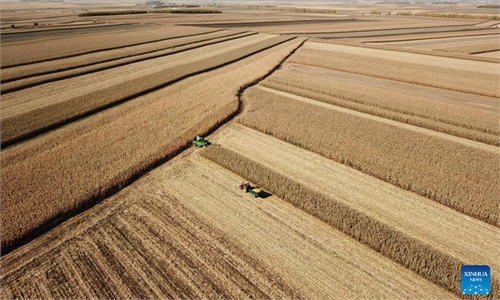Annual grain output to set record, as more than 96% of autumn harvest completed in China

In this aerial photo taken on Oct 2, 2023, farmers harvest rice in a paddy field in Baihecang Village, Yongzhou City of central China's Hunan Province. Photo:Xinhua
China has nearly completed its autumn harvest as scheduled, harvesting more than 96 percent of the autumn grain crops so far, despite extreme weather in some regions.
Observers said that the figures indicate the timely progression of this year's autumn harvest, with some foreseeing a consistent increase in grain output. This positive trend is seen as a favorable factor for ensuring the country's food security.
According to a recent update from the Ministry of Agriculture and Rural Affairs (MOA), the near completion of corn, soybean and mid-season rice harvests, along with the acceleration of the late rice harvest in the southern regions, has propelled the progress of the national autumn grain harvest to 96.2 percent, essentially achieving a bumper harvest, the People's Daily reported on Sunday.
Meanwhile, autumn and winter planting is progressing systematically nationwide.
As of Friday, more than 90 percent of the planned winter wheat sowing area had been completed, with the country's northwestern region finishing sowing. The Huang-Huai-Hai region, which includes a wide range of areas ranging from Beijing and Tianjin to East China's Shandong Province and some parts of Central China's Henan, North China's Hebei, East China's Anhui and Jiangsu Provinces, and which represents about three-quarters of the country's summer grain output, was at 95 percent. The middle and lower reaches of the Yangtze River and South China were at 75 percent, and the southwestern regions were at 60 percent.
The intended winter rapeseed sowing area has seen completion rates exceeding 95 percent nationally, especially in the middle and lower reaches of the Yangtze River and more than 90 percent in the southwestern region.
Despite challenges such as floods and drought in certain areas throughout the year, China's grain production has overcome these adversities, with the annual grain output anticipated to reach a new high.
China's annual grain output is expected to hit a record high in 2023, with a total of more than 1.3 trillion jin (650 billion kg) for the ninth consecutive year, while the output for the autumn harvest is set to increase, the MOA said on October 23, assuring the nation's food security.
Li Guoxiang, a research fellow at the Chinese Academy of Social Sciences, told the Global Times on Sunday that despite extreme weather in certain parts of the country, the impact on agricultural production has been generally controllable, thanks to the government's measures.
"In recent years, favorable market conditions and robust policy support motivated farmers to actively engage in grain cultivation, resulting in an expanded cultivation area and subsequently higher yields," Li said.
Localities are also actively promoting high-quality seeds, Li noted, indicating another factor that contributes to higher yields.
The strategy of increasing unit yields in extensive areas is proving effective. This year, the nation's focus is on enhancing unit yields in 200 major corn-planting counties and 100 major soybean-producing counties through a comprehensive system, the MOA said.
Moreover, the Chinese government is implementing policies covering farm management, harvesting, field planting and pesticides and fertilizers. Emphasis is placed on promoting corn and soybean densification, precise control of fertilizer and water, and a unified spraying approach in the middle and late stages, among other key measures.
Preliminary estimates indicate that the contribution of increased unit yields to the grain harvest in 300 key counties has reached 73 percent, according to the MOA. This has effectively hedged against the impact of floods, droughts and other disasters on food production.
"The smooth autumn harvest and the expanded grain output bodes well for the nation's strategy for food security, and helps China better deal with fluctuating food prices in the world market," Li said.

